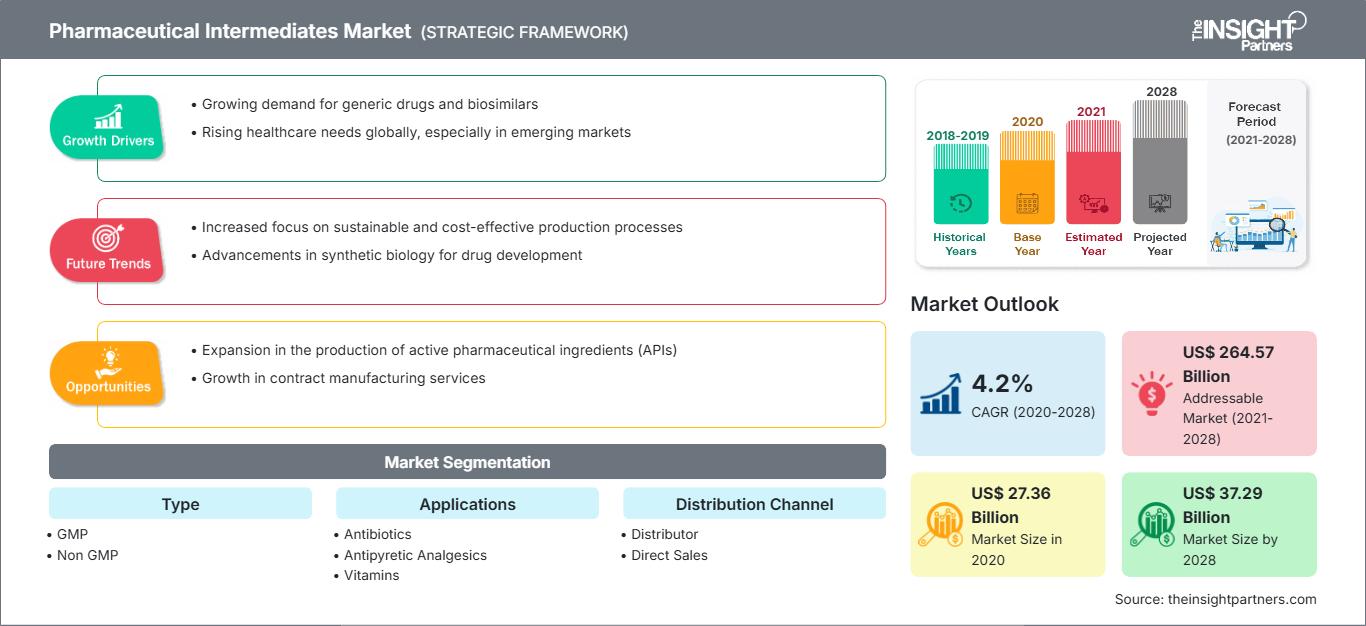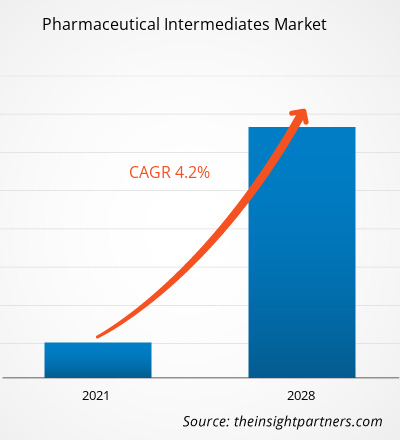제약 중간체 시장은 2020년 273억 5,670만 달러에서 2028년 372억 9,033만 달러로 성장할 것으로 예상됩니다. 이 시장은 2021년부터 2028년까지 연평균 4.2% 성장할 것으로 예상됩니다.
제약 중간체 시장은 유형, 용도, 유통 채널 및 지역을 기준으로 분석되었습니다. 지역별 시장은 북미, 유럽, 아시아 태평양, 중동 및 아프리카, 중남미로 구분됩니다. 본 보고서는 시장 동향, 기술 발전, 시장 역학, 주요 기업의 경쟁 환경 분석 등의 요소를 중점적으로 분석하여 제약 중간체 시장에 대한 통찰력과 심층 분석을 제공합니다. 또한 모든 주요 지역의 시장 전반에 걸친 COVID-19 팬데믹 분석도 포함되어 있습니다.
요구 사항에 맞게 이 보고서를 사용자 정의하십시오.
이 보고서의 일부, 국가 수준 분석, Excel 데이터 팩을 포함하여 모든 보고서에 대한 사용자 정의를 무료로 받을 수 있을 뿐만 아니라 스타트업 및 대학을 위한 훌륭한 제안 및 할인을 이용할 수 있습니다
제약 중간체 시장: 전략적 통찰력

-
이 보고서의 주요 주요 시장 동향을 확인하세요.이 무료 샘플에는 시장 동향부터 추정 및 예측에 이르기까지 데이터 분석이 포함됩니다.
의약품 중간체는 활성 의약품 성분(API)의 구성 요소입니다. 이는 대량 의약품 생산 과정에서 분자 변화 또는 가공 과정을 거치는 원료 물질입니다. 따라서 만성 질환 치료제에 대한 수요 증가에 따라 의약품 중간체에 대한 수요도 증가하고 있습니다. 미국 질병통제예방센터(CDC)에 따르면, 미국 성인 10명 중 6명은 암, 심장 질환, 폐 질환, 뇌졸중, 신경 질환, 당뇨병, 신장 질환 등 최소 한 가지 만성 질환을 앓고 있습니다. 또한, 미국 성인 10명 중 4명은 두 가지 이상의 만성 질환을 앓고 있습니다. 또한, 유럽 만성 질환 연맹(ECDA)의 보도자료에 따르면 2014년 유럽에서는 10명 중 9명이 만성 질환으로 사망했습니다. 따라서 전체 의료비의 70~80%가 만성 질환 관리에 지출되고 있습니다.
특히 동남아시아 지역에서 감염성 질환의 급증은 향후 몇 년 동안 API(원료의약품) 수요를 촉진하여 궁극적으로 의약품 중간체 시장의 성장을 견인할 것으로 예상됩니다. 예를 들어, 개정된 국가 결핵 관리 프로그램 보고서에 따르면 2018년 인도에서 약 44만 명의 환자가 결핵으로 사망했으며, 이는 전 세계 결핵 사망자 150만 명의 29%에 해당합니다. 이처럼 만성 질환과 감염성 질환의 높은 유병률은 의약품 수요를 증가시키고 있으며, 궁극적으로 의약품 중간체에 대한 필요성을 부각시키고 있습니다.
유형 기반 인사이트
의약품 중간체 시장은 유형별로 GMP(우수 의약품 제조) 및 비GMP(비우수 의약품 제조)로 구분됩니다. GMP 부문은 2020년 시장 점유율이 가장 높았으며, 예측 기간 동안 시장에서 가장 높은 연평균 성장률(CAGR) 4.4%를 기록할 것으로 예상됩니다.
응용 분야 기반 인사이트
제약 중간체 시장은 응용 분야별로 항생제, 해열 진통제, 비타민 등으로 세분화됩니다. 항생제 부문은 2020년 시장 점유율이 가장 높았으며, 예측 기간 동안 시장에서 가장 높은 연평균 성장률(CAGR) 4.9%를 기록할 것으로 예상됩니다.
유통 채널 기반 인사이트
유통 채널을 기준으로 제약 중간체 시장은 유통업체와 직접 판매로 세분화되었습니다. 직접 판매 부문은 2020년에 시장에서 가장 큰 점유율을 차지했으며, 유통 부문은 예측 기간 동안 시장에서 가장 높은 CAGR 4.2%를 기록할 것으로 추산됩니다.
제약 중간체 시장에서 운영되는 회사들은 전 세계적으로 영향력과 제품 포트폴리오를 확장하고 증가하는 수요를 해결하기 위해 제품 출시 및 확장과 같은 유기적 전략을 채택하고 있습니다.
제약 중간체 시장 지역별 통찰력
The Insight Partners의 분석가들은 예측 기간 동안 제약 중간체 시장에 영향을 미치는 지역별 동향과 요인들을 면밀히 분석했습니다. 이 섹션에서는 북미, 유럽, 아시아 태평양, 중동 및 아프리카, 그리고 중남미 지역의 제약 중간체 시장 부문 및 지역별 현황도 다룹니다.
제약 중간체 시장 보고서 범위
| 보고서 속성 | 세부 |
|---|---|
| 시장 규모 2020 | US$ 27.36 Billion |
| 시장규모별 2028 | US$ 37.29 Billion |
| 글로벌 CAGR (2020 - 2028) | 4.2% |
| 이전 데이터 | 2018-2019 |
| 예측 기간 | 2021-2028 |
| 다루는 세그먼트 |
By 유형
|
| 포함된 지역 및 국가 |
북미
|
| 시장 선도 기업 및 주요 회사 프로필 |
|
제약 중간체 시장 참여자 밀도: 비즈니스 역학에 미치는 영향 이해
제약 중간체 시장은 소비자 선호도 변화, 기술 발전, 그리고 제품의 효능에 대한 인식 제고 등의 요인으로 인한 최종 사용자 수요 증가에 힘입어 빠르게 성장하고 있습니다. 수요가 증가함에 따라 기업들은 제품 라인업을 확장하고, 소비자 니즈를 충족하기 위한 혁신을 추진하며, 새로운 트렌드를 적극 활용하고 있으며, 이는 시장 성장을 더욱 가속화하고 있습니다.

- 을 얻으세요 제약 중간체 시장 주요 주요 플레이어 개요
- GMP
- 비GMP
용도별
- 항생제
- 해열 진통제
- 비타민
- 기타
유통 채널별
- 유통업체
- 직접 판매
지역별
-
북미
- 미국
- 캐나다
- 멕시코
-
유럽
- 독일
- 프랑스
- 이탈리아
- 영국 왕국
- 스페인
- 스위스
- 벨기에
- 그리스
- 노르웨이
- 포르투갈
- 스웨덴
- 체코 공화국
- 크로아티아
- 아일랜드
- 덴마크
- 네덜란드
- 러시아
- 유럽 나머지 지역
-
아시아 태평양(APAC)
- 중국
- 인도
- 대한민국
- 일본
- 호주
- 나머지 국가 APAC
-
중동 및 아프리카(MEA)
- 남아프리카
- 사우디아라비아
- UAE
- 터키
- 나머지 MEA의
-
남중미(SCAM)
- 브라질
- 아르헨티나
- 기타 SCAM 국가
회사 프로필
- Pfizer, Inc
- Dishman Group
- Dextra Laboratories Limited
- Sanofi Winthrop Industries SA
- Vertellus Holdings LLC
- BASF SE
- Lianhetech
- Codexis
- Midas Pharma GmbH
- Chiracon GmbH
- 과거 분석(2년), 기준 연도, CAGR을 포함한 예측(7년)
- PEST 및 SWOT 분석
- 시장 규모 가치/거래량 - 글로벌, 지역, 국가
- 산업 및 경쟁 환경
- Excel 데이터세트
최근 보고서
관련 보고서
사용 후기
구매 이유
- 정보에 기반한 의사 결정
- 시장 역학 이해
- 경쟁 분석
- 고객 인사이트
- 시장 예측
- 위험 완화
- 전략 기획
- 투자 타당성 분석
- 신흥 시장 파악
- 마케팅 전략 강화
- 운영 효율성 향상
- 규제 동향에 발맞춰 대응






















 무료 샘플 받기 - 제약 중간체 시장
무료 샘플 받기 - 제약 중간체 시장